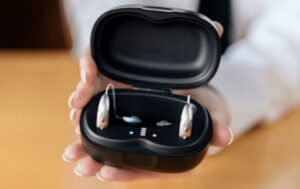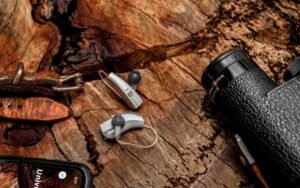Oticon vs Phonak vs ReSound and More: Comparison of Top Hearing Aid Brands
Choosing the right hearing aid can be overwhelming with so many trusted names on the market. This guide breaks down the leading prescription hearing aid brands: Phonak, Oticon, Widex, Starkey, Signia, and ReSound, to help you choose the right one for your needs.
Rather than focusing on specific models, this article provides a brand-level overview to help you identify which manufacturer best suits your hearing needs and lifestyle. We explore the most important aspects of modern hearing aids, including sound performance, connectivity, comfort, reliability, rechargeability, and innovation.
Overview of Top Hearing Aid Brands
| Brand | Notable Strengths | Flagship Technology | Typical Price Range | Ideal For |
| Oticon | Natural, brain-inspired sound; seamless adaptation across environments | Deep Neural Network 2.0; BrainHearing™; Intent Platform | $$$–$$$$ | Individuals seeking realistic, comfortable hearing across varied settings |
| Phonak | Robust connectivity, waterproof options, and consistent performance | AutoSense OS 5.0; DEEPSONIC™ DNN Chip | $$$–$$$$ | Active, tech-oriented users who need strong connectivity |
| ReSound | Superior spatial awareness and personalisation | OMNIA Platform; Smart 3D App; LE Audio | $$$ | Users who value spatial awareness and custom tuning |
| Signia | Stylish designs and multi-speaker clarity | Augmented Xperience (AX); Real-Time Conversation Enhancement (RTCE) | $$$–$$$$ | Socially active users prioritising design and clarity |
| Starkey | Exceptional battery life and wellness integration | Edge AI; Health and Motion Sensors | $$$ | Users who want hearing aids with smart health features |
| Widex | Natural tone and tinnitus relief | PureSound™; Zen and SoundRelax | $$$ | Individuals sensitive to harsh amplification or with tinnitus |
Top Hearing Aid Brands
Today’s leading hearing aid manufacturers combine advanced technology with user-focused design to enhance everyday hearing experiences. The following brands represent the forefront of innovation, sound quality, and reliability.
Oticon
![]()
Oticon is a leading brand in hearing technology, best known for its pioneering BrainHearing™ approach and natural sound processing. Unlike conventional hearing aids that simply amplify sound, Oticon’s technology supports the way the brain interprets sound, helping you hear more clearly and comfortably in real-life environments. The system continuously scans the sound environment 100 times per second, giving you access to 360° sounds that allow your brain to locate and focus on what’s important while staying aware of your surroundings.
At the heart of Oticon’s innovation is its Deep Neural Network (DNN), a powerful artificial intelligence system that understands and adjusts to sounds in real time. Trained with over 12 million real-life sound scenes, it seamlessly recognises and adapts to different environments, creating a natural 360° listening experience. This allows you to follow conversations from any direction with clarity and ease, reducing listening effort and ensuring speech sounds clear and natural, even in busy or noisy settings.
In addition to its powerful processing, Oticon provides Auracast-ready connectivity and discreet rechargeable designs, making it suitable for a wide range of users. The Oticon Companion app enables remote adjustments and even teleconsultations with your audiologist by appointment. However, note that not all fine-tuning can be done remotely, with some adjustments still requiring an in-clinic visit for optimal results.
| Pros | Cons |
| ● Natural and relaxed sound experience
● Superior noise management using DNN 2.0 ● Reduced listening effort with BrainHearing™ ● Adapts automatically to movement and environment ● Sleek, modern design with Auracast readiness |
● Requires ConnectClip or LE Adaptor for audio streaming in some Android phone models
● Some fine-tuning still needs an in-clinic visit |
Phonak

Phonak is renowned for its powerful speech-in-noise performance and universal Bluetooth compatibility, offering clear communication and seamless connectivity across a wide range of devices. Its advanced AutoSense OS and DEEPSONIC chip automatically analyse and adapt to different listening environments, ensuring smooth transitions and optimal sound clarity whether you’re in a quiet room or a busy café.
Certain models of Phonak hearing aids help enhance everyday convenience with hands-free stereo calls and waterproof protection, making them ideal for individuals with active or outdoor lifestyles. The myPhonak app further adds flexibility by allowing you to personalise sound settings, track hearing aid performance, and communicate remotely with your audiologist for fine-tuning.
With a focus on practicality, durability, and robust engineering, Phonak offers hearing solutions that deliver dependable performance and effortless listening in real-world conditions.
| Pros | Cons |
| ● Excellent speech-in-noise handling
● True universal Bluetooth (both Android and iOS) ● Waterproof build options (IP68+) ● Consistent sound across environments |
● Higher power consumption
● Pricier replacement parts ● Some fine-tuning still needs an in-clinic visit |
ReSound

ReSound is a pioneer in spatial hearing technology, designed to help you experience a more natural sense of sound direction and placement. Its advanced OMNIA platform enhances awareness of directionality in complex listening environments, making it easier to focus on conversations while remaining aware of surrounding sounds. This creates a more realistic and balanced listening experience that closely mimics natural hearing.
ReSound’s design philosophy centres on realism and localisation, allowing you to sense where each sound originates, whether in quiet or noisy settings. The ReSound Smart 3D app offers convenient control, allowing you to activate favourite programmes, adjust volume, or use the sound enhancer feature to optimise comfort. While hearing aid fittings and precise fine-tuning still need to be performed by an audiologist, the app allows for meaningful personalisation and remote support to maintain an effortless listening experience.
| Pros | Cons |
| ● Exceptional sound spatialisation
● Strong app-based customisation ● Comfortable, realistic sound balance ● Reliable connectivity (Bluetooth LE Audio ready) |
● App features can be complex for new users
● Slightly bulkier behind-the-ear designs ● Some fine-tuning still needs an in-clinic visit |
Signia

Signia combines high performance with modern aesthetics, offering sleek, earbud-like designs that blend advanced technology with discreet style. Its Real-Time Conversation Enhancement (RTCE) technology intelligently tracks multiple speakers, allowing you to maintain focus on conversations even in dynamic and noisy environments.
Powered by the Signia AX platform, these hearing aids utilise split processing to separate speech from background noise in real-time, delivering clear, natural sound without distortion. In addition to strong speech performance, Signia offers attractive, contemporary styles and a user-friendly companion app that provides quick access to settings, sound adjustments, and personalised controls for everyday convenience.
| Pros | Cons |
| ● Stylish and discreet design options
● Excellent group conversation clarity ● Real-time adaptive processing ● Easy-to-use app and adjustments |
● No Telecoil support on some models
● Slightly higher price for cosmetic designs |
Starkey

Starkey stands out for its long-lasting rechargeable batteries and advanced built-in health sensors, offering exceptional hearing performance and overall wellness support. Powered by the Edge AI platform, Starkey hearing aids integrate fall detection, heart-rate tracking, and fitness data monitoring, making them one of the most health-focused options available today.
The brand emphasises telehealth accessibility through its My Starkey app, which allows for immediate sound adjustments, including changes to hearing aid settings, streaming calls and TV audio, and even remote fine-tuning by your audiologist when needed. This makes Starkey a good choice for individuals seeking a balance between high-quality hearing, smart connectivity, and holistic wellness monitoring in one device.
| Pros | Cons |
| ● Industry-leading battery life (up to 51 hours)
● Built-in motion and health sensors ● Strong telehealth connectivity ● Consistent recharge reliability |
● Some features are limited to higher-end models
● Accessory required for manual adjustments |
Widex

Widex is known for its commitment to creating calm, natural sound environments that minimise listening fatigue and promote a more comfortable hearing experience. Its unique Zen and SoundRelax programmes integrate soothing tones and tinnitus relief options, helping you manage stress and maintain focus throughout the day.
Favoured by those sensitive to artificial or overly sharp amplification, Widex hearing aids deliver a smooth, rich sound signature that feels natural and balanced. This makes them particularly well-suited for quiet listening settings and music enjoyment, where subtle sound detail and tonal quality are most appreciated.
| Pros | Cons |
| ● Effective tinnitus relief features
● Smooth, natural sound quality ● Intuitive app interface ● Comfortable all-day listening |
● Slightly less effective in very noisy environments |
How to Choose the Right Hearing Aid for You
Choosing the right hearing aid is a collaborative process between you and your audiologist. While your audiologist will recommend the most suitable device based on your hearing test results and daily needs, it helps to understand the factors that guide this decision. Here are some key aspects to discuss during your consultation:
- Severity and configuration of hearing loss:Your audiologist will match a model to your hearing range and loss pattern to ensure balanced amplification and clear sound.
- Need for speech-in-noise performance:If you often engage in conversations in noisy settings, consider hearing aids with advanced noise management features.
- Bluetooth streaming needs and multi-device use: Discuss connectivity options if you frequently stream calls, music, or media across multiple devices.
- Battery life and recharge style:Choose between rechargeable or disposable batteries depending on your lifestyle, finger dexterity, and daily routine.
- Durability and waterproofing: Ask about water-resistant or rugged models if you spend time outdoors, exercise/sweat heavily or live in humid environments.
- Comfort, custom tips, and ear anatomy: A proper fit enhances both comfort and sound quality. Your audiologist can customise tips or earmoulds to suit your ear shape and preferences.
FAQs About Top Hearing Aid Brands
Should I get over-the-counter (OTC) or prescription hearing aids?
Choosing between OTC and prescription hearing aids depends on your hearing needs, lifestyle, and how much personalisation you require.
OTC hearing aids (including AirPods Pro 2) are designed for adults with self-perceived mild hearing loss who want quick, accessible solutions without seeing an audiologist. They can be purchased online or in stores and are useful if you want to try amplification before committing to a higher-quality device. However, OTC hearing aids are not customised, as they lack professional fine-tuning and may not adequately address complex or progressive hearing loss.
Prescription hearing aids, on the other hand, are tailored to your specific hearing profile. After a hearing assessment, your audiologist will recommend, fit, and program the device for optimal sound and comfort. These models often feature advanced technology, better sound precision, and ongoing professional support. Regular check-ups also help ensure your hearing aids continue to perform well over time and that any underlying conditions are monitored.
While OTC devices offer convenience with their one-size-fits-all concept, prescription hearing aids deliver more precise and reliable hearing support. They also take into account long-term factors such as all-day comfort, battery longevity, and safe yet effective levels of auditory stimulation. It’s best to consult a hearing care professional for advice based on your hearing profile and lifestyle needs.
Which is the best brand of prescription hearing aids?
There is no single “best” brand of prescription hearing aids, as the right choice depends on your hearing profile, listening environments, and personal preferences. A comprehensive hearing assessment and professional fitting are essential to determine the device that suits your hearing loss, lifestyle, and comfort needs.
All major manufacturers, including Oticon, Phonak, ReSound, Signia, Starkey and Widex, produce high-quality prescription hearing aids with advanced technology, such as noise reduction, tinnitus management, and Bluetooth connectivity. Your audiologist can help you compare models and features to find the one that best supports your daily hearing goals.
What are the best hearing aids for tinnitus?
Most modern prescription hearing aids now include tinnitus management tools, so the “best” option depends on how well the features align with your tinnitus and hearing needs.
Hearing aids can help with tinnitus by improving overall hearing, reducing listening strain, and amplifying ambient sounds that naturally mask tinnitus. Many also offer dedicated tinnitus relief programs with adjustable masking sounds or relaxation tones. For instance, Oticon’s Tinnitus SoundSupport™ offers customisable masking sounds, while Widex incorporates Zen therapy tones backed by tinnitus research.
The most effective approach is to consult an audiologist who can recommend and program a device that addresses both your hearing loss and tinnitus profile.





